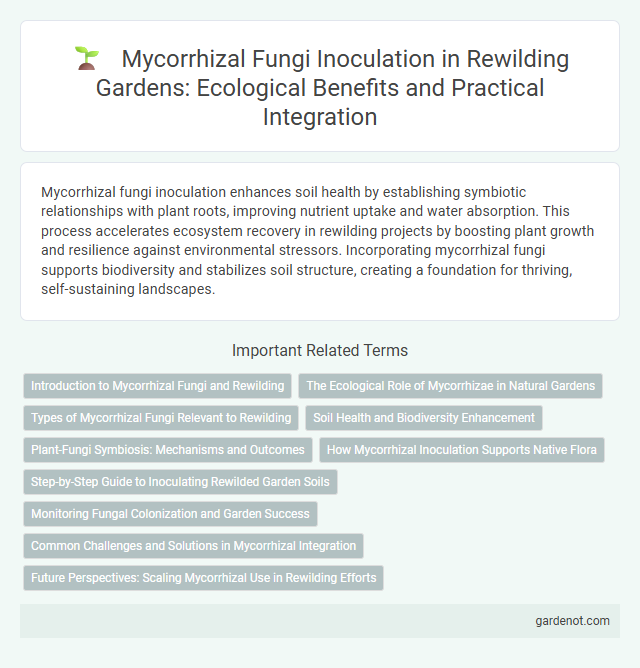Mycorrhizal fungi inoculation enhances soil health by establishing symbiotic relationships with plant roots, improving nutrient uptake and water absorption. This process accelerates ecosystem recovery in rewilding projects by boosting plant growth and resilience against environmental stressors. Incorporating mycorrhizal fungi supports biodiversity and stabilizes soil structure, creating a foundation for thriving, self-sustaining landscapes.
Introduction to Mycorrhizal Fungi and Rewilding
Mycorrhizal fungi form symbiotic relationships with plant roots, enhancing nutrient uptake and soil health essential for rewilding projects. Their inoculation accelerates the restoration of degraded ecosystems by improving plant establishment and biodiversity. Integrating mycorrhizal fungi inoculation in rewilding supports ecosystem resilience and carbon sequestration.
The Ecological Role of Mycorrhizae in Natural Gardens
Mycorrhizal fungi form symbiotic relationships with plant roots, enhancing nutrient and water uptake critical for plant health in natural gardens. These fungi improve soil structure by increasing organic matter and promoting microbial diversity, which supports ecosystem resilience and biodiversity. Their role in carbon sequestration further contributes to soil fertility and climate regulation, making them essential for sustainable rewilding efforts.
Types of Mycorrhizal Fungi Relevant to Rewilding
Arbuscular mycorrhizal fungi (AMF) form symbiotic relationships with most herbaceous plants, enhancing nutrient uptake and soil structure in rewilding projects. Ectomycorrhizal fungi (EMF) associate primarily with woody plants, playing a key role in forest restoration by improving tree health and resilience. Ericoid mycorrhizal fungi (ErMF) support ericaceous shrubs, facilitating nutrient acquisition in nutrient-poor soils common in rewilded heathlands and bogs.
Soil Health and Biodiversity Enhancement
Mycorrhizal fungi inoculation significantly improves soil health by enhancing nutrient cycling and increasing soil organic matter, which promotes plant growth and resilience. This symbiotic relationship fosters biodiversity by supporting a diverse range of plant species and soil microorganisms vital for ecosystem stability. Integrating mycorrhizal fungi into rewilding projects accelerates habitat restoration and strengthens ecological networks.
Plant-Fungi Symbiosis: Mechanisms and Outcomes
Mycorrhizal fungi inoculation enhances plant root systems by forming symbiotic associations that improve nutrient uptake, particularly phosphorus and nitrogen, essential for plant growth in rewilded ecosystems. This mutualistic relationship increases soil microbial diversity and fosters resilience against environmental stresses, amplifying ecosystem restoration success. Enhanced carbon sequestration through mycorrhizal networks further supports long-term soil health and biodiversity recovery in rewilding projects.
How Mycorrhizal Inoculation Supports Native Flora
Mycorrhizal fungi inoculation enhances native flora by establishing symbiotic relationships that improve nutrient uptake, particularly phosphorus and nitrogen, essential for plant growth. This biological alliance increases plant resilience to environmental stressors such as drought and soil pathogens, promoting robust ecosystem recovery during rewilding efforts. Inoculation also facilitates soil structure improvement and biodiversity by supporting a diverse microbial community critical for sustaining native plant populations.
Step-by-Step Guide to Inoculating Rewilded Garden Soils
Begin by selecting a high-quality mycorrhizal fungi inoculant tailored to native plant species commonly found in rewilded ecosystems. Prepare the soil by gently loosening the top layer to enhance fungal spore contact and spread the inoculant evenly across the root zone. Water the soil thoroughly after application to activate the fungi, promoting symbiotic relationships that improve nutrient uptake and plant resilience in rewilded garden soils.
Monitoring Fungal Colonization and Garden Success
Monitoring fungal colonization through periodic root sampling and microscopic analysis ensures effective mycorrhizal fungi inoculation in rewilding projects. Tracking root colonization rates alongside plant health indicators such as growth rate and nutrient uptake provides critical data to assess garden success. Integrating soil enzyme activity measurements further validates symbiotic functionality and long-term ecosystem restoration outcomes.
Common Challenges and Solutions in Mycorrhizal Integration
Mycorrhizal fungi inoculation often faces challenges such as low survival rates of fungi in degraded soils, competition with native microbial communities, and improper matching of fungal species to host plants. Solutions include selecting site-specific fungal strains, improving soil conditions through organic amendments, and employing inoculants with high propagule density to enhance symbiotic establishment. Successful mycorrhizal integration in rewilding projects depends on adaptive management and ongoing monitoring to ensure effective colonization and ecosystem restoration.
Future Perspectives: Scaling Mycorrhizal Use in Rewilding Efforts
Scaling mycorrhizal fungi inoculation in rewilding efforts offers promising future perspectives for ecosystem restoration and resilience. Advances in fungal cultivation techniques and inoculum delivery methods enable large-scale application in diverse habitats, enhancing plant establishment and nutrient cycling. Integrating mycorrhizal inoculation with remote sensing and soil health monitoring systems can optimize site-specific treatments and accelerate ecological recovery.
Mycorrhizal fungi inoculation Infographic

 gardenot.com
gardenot.com